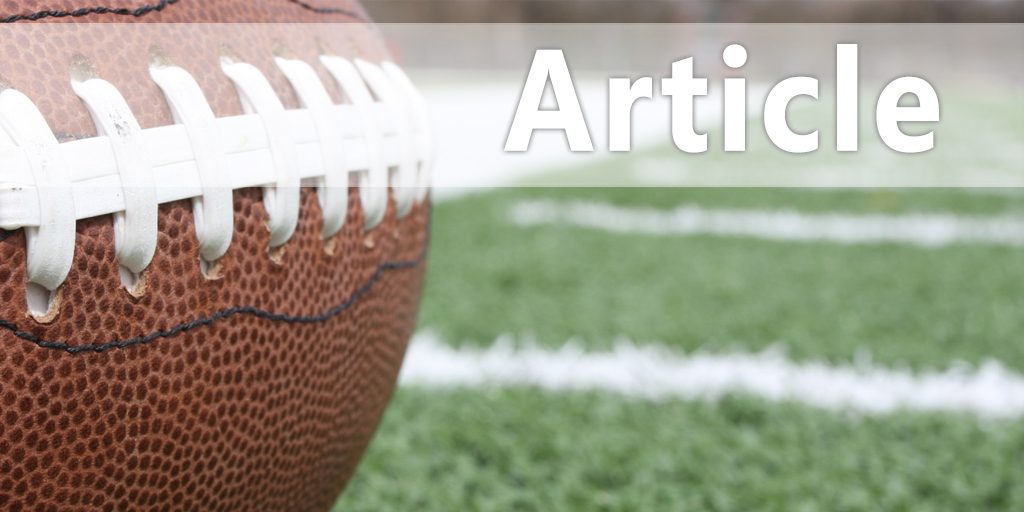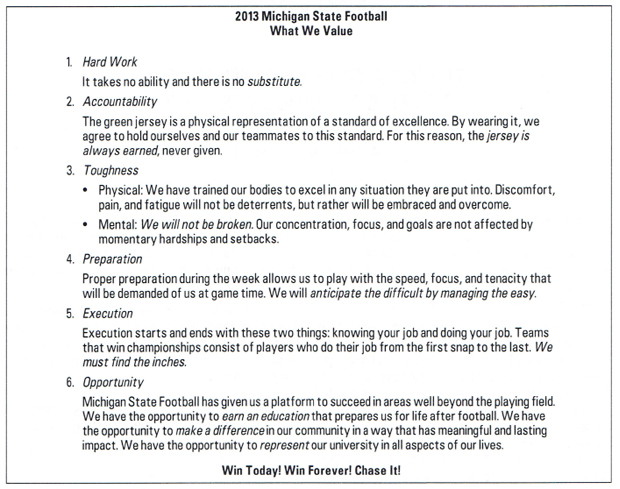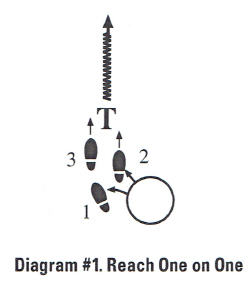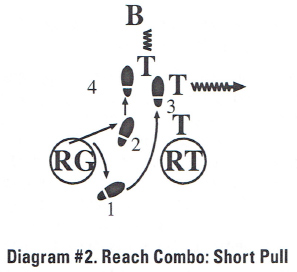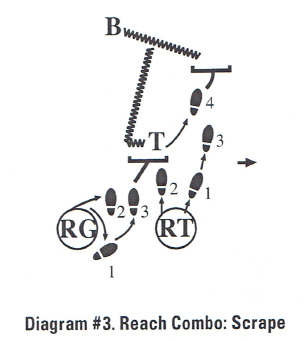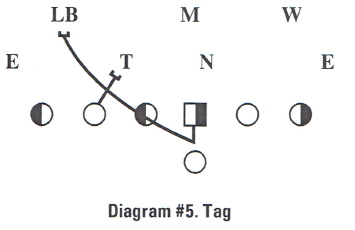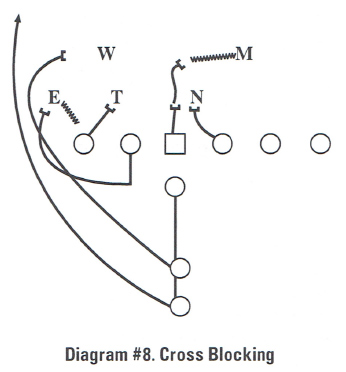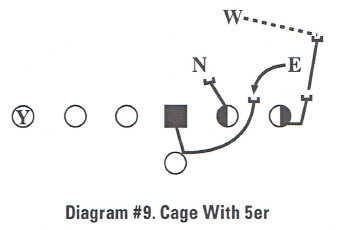|
The Ins and Outs of Michigan State's Outside Zone Play By: Mark Staten Originally Published in: 2014 Offensive Coaches Handbook - by Early Browning
When you look at our offensive line team picture, you will see I am the biggest guy in the picture with the exception of one walk-on. Our starting right tackle was 6'3 1/2" Our starting guard was 6'5", and he got hurt going into the bowl game, so we started a guy who was 6'3". Our starting center was 6'1" on a good day. Our other guard was 6'2", and our left tackle was a 6'5 1/2" freshman. This required us to do a lot with the hands. We studied what the defenders were trying to do, so we worked on taking away the hands of the defenders. I will talk about those techniques as we go. I want to show you our value statements for our 2013 team. Coach Dantonio has each new team come up with their statements, and it becomes what we are all about (Table #1). When you look at the list you see things like hard work, accountability, and toughness. If you saw the Big 10 championship game or the Rose Bowl game you saw two teams really getting after it at a very high level. You also see the word opportunity. We are all blessed to be here today because someone gave you the opportunity at some point in time to be involved in this phenomenal game. What you do with that opportunity is up to you. I was talking to Bob Wylie earlier, and he made the comment that sometimes people are afraid to fail. I told Bob when he called to invite me here that I come to the C.O.O.L. Clinic to learn from guys like Paul Alexander, Jim McNally, Bob Wylie, and Dante Scarnecchia. Bob said, "Hey it's your turn. This is your opportunity." I found out later that he takes the young line coaches and he feeds them to the wolves first, so I thank you for that, Bob. Let me move to our run blocking fundamentals. Any great coach is a great thief, and I stole these from someone. We have these posted in the back of our room. When our offensive linemen come in, they see this every day. RUN BLOCKING FUNDAMENTALS: FOUR CRITICAL ELEMENTS IN RUN BLOCKING • Eyes on Aiming Point: Speed to the target is essential. Eyes on the Aiming Point Speed is essential. How many of you stand behind your players in almost every drill they run, and coach them from there? The majority of you do, because that is the way we were taught to do it. A few years ago, someone told me to stand in front and watch them. It doesn't have to be all of the time. Do it in certain drills so you can see where their eyes are. See what they are looking at. You will be shocked, even at our level, how many guys close their eyes at the moment of impact. That is why you will see me on the tape in front, coaching my guys. Make sure you see where their eyes are going and that they are going to their aiming point. Establish Leverage
That is a no-brainer. Get your pads under the defense. Elbows In We are constantly talking about keeping the elbows in. We are constantly talking about keeping the thumbs up. We talk about keeping their weight on their instep. Drive Your Backside Knee What that means is you have got to get your second step down. One way or the other, you have got to get that second step down. Some guys might need to lose a little ground on the first step in order to gain ground on the second step. As you watch your guys, each guy is a little different. We are all offensive linemen, so we are a little different anyway. As you coach your guy, make sure you are coaching that guy. Make sure you are using what that guy does best in order to help your program. We would all like to do it the same way, me included. When you are dealing with guys from 61" to 6'6", there are a lot of differences between each guy. Some guys have long arms; some guys have short arms, and so forth. OUTSIDE ZONE PLAY • Stay simple Let's talk about the outside zone play. It is our stretch run play. It is our 36-37 run play. We try to stay simple. We do the outside zone in two different ways. We will go with covered and uncovered, and then we go with pin and pull. I will talk about that as we go. We will pin the 3 technique and pull the guard. You would be amazed to see some of the combinations that we end up blocking with it. I think the first time we ran it, we actually stumbled across it. From that point on, we thought, "Hey this works. Let's go ahead and coach it." We will talk about the main principles of covered and uncovered first. The covered and uncovered rules are very simple. If I am covered with a 5 technique and I am the right tackle running an openside outside zone, and the guy inside of me is uncovered, he is going to short pull and he is going to help me. So if I get the 5 technique spiking inside, he is going to help me pick that up, and I will work up to the linebacker. Our footwork is the same as if you were covered to the frontside. If I am a covered tight end, it is the same. If I am a covered guard or tackle, it is the same. Where problems start to happen is when you get 2is, when you have inside shades on the guards. Now he has to help the center, and the tackle is all by himself. What happens to the tackle now? He doesn't stretch it as much because he is worried about the 5-technique spike. We have found ways to pin with the guard and pull the center, and the double-team will be with the center and right tackle. We will talk more about this in a minute. It is just another way to get it done, and it works for us. Make it fit your system. Whatever offense you run, you can make the outside zone fit your system. I think this will help you be a better football team. A year ago (in 2012), we averaged 30 yards less per game than what we did this year, and we had Le'Veon Bell, who is now playing with the Pittsburgh Steelers. I think this play helped our average go up a whole yard every time we called it. Let's take a look at it. STRETCH RULES • Wide zone blocking scheme We use zone blocking rules. We try to have 18-inch splits. That is our normal alignment. Our back reads the end man on the line of scrimmage. He is keying the end man and based on what that guy does will determine if our back will cut it up inside or take it outside. Is it a zone reach or tight reach? Following are our normal reach steps. If I am a guard with a 3 technique or a tight end covered with a 9 technique, I want to take the first step at an angle that will put my toes pointing outside of his outside shoe. My second step is to a point that is splitting his crotch. My third step has to establish leverage and gain something. Whether it is an inch, two inches, three inches, we would like to gain a lot. We want the third step to be upfield. We have found from looking at our drills, the guys who can get their second step down with their seat going more north and south, the better chance he has of pushing up and through in order to drive the defender. He doesn't have to be perfectly aligned north and south going down the field. Once the defender starts to lose his leverage, the stretch is beginning to open up. We want to take our inside hand and drive it through his down hand and drive it through his chest. We want to take his hand away from him as we go through our block. They always have their inside hand down. I want to drive my hand through his inside hand and pin it into his sternum. I think this technique is a big reason we were able to take our guys with short arms and dominate people at the line of scrimmage, because we take away their hands, Now we move to covered without help, tight reach. Now, instead of driving the hand through the sternum, our hand is going to the near breast plate. We are not expecting any help to the inside, so we are expecting to drive the defender out. As he is fighting for position, we are going to let his momentum help us drive him out. He is trying to keep everything inside of him, so he is moving that way. We are counting on the running back to be able to read his block, and the end guy on the line of scrimmage. Uncovered is the short puller. The short puller is literally checking out the near knee of the defender as he opens up. On his third step, he is deciding if he is helping on the covered defender or if he is working his way up to take on the linebacker. Sometimes, the backside defensive end is a chaser. You may need to slow him down a little bit. By formation, we would like to keep the linebacker outside of the box. We want to run off the ball when zone blocking. We have to know that we have help and we want to use it. Trust in your teammates. We have to be alert of calls at the line of scrimmage, Sometimes, you might have a safety coming up and you have to go one man past. (Film) This first drill is 1-on-1 where we were getting a lot of 3 techniques spiking (Diagram #1). When he gets off the ball, you want him to get his hands inside with a little leverage. I am looking to see if he gets his second step on the ground, splitting the crotch and is working and driving off of his insteps. I am looking to see if he can capture the arm of the defender as he come up into his chest.
The next thing we go to is reach combos. You have to be able to short pull with the reach combos (Diagram #2).
You will notice the right guard's first step is also pointed outside the down defender's outside shoe. This is where the short pull concept comes in. If the defender spikes inside, he will collect him. We want the tackle to keep his shoulders square and work up to the linebacker. If the down defender doesn't spike, the tackle has to stay on him long enough and then his shoulders square for the linebacker (Diagram #3). Sometimes, the defense will be in a 4 or 5 technique. You have to be able to reach those guys. You are going to work on these combos hard for that week. On occasion, you will see our inside guy take his hand and push the outside guy off the double-team. That is a no-no. The tackle will leave the block when it is time to leave that block. People ask me, "When is the proper time to leave the block?" The proper time is when you have to. First things first. We talk to our guys about taking care of the down defender first. First and foremost, take care of the down defender. When the down defender is secure, you can move up to the second level. You have to work it with the tight ends and tackles as well. You would like your helmet to the outside against the linebacker when he gets to the second level, just like on the down defender.
When we introduce a play in the springtime, we try to go with a set number of rules for the offensive line. For us, we go with three. These are the rules for our stretch. Offensive Line Stretch Rules (2012) • Covered/uncovered I will quiz our guys about their three rules throughout the spring. We can add tag words when variants occur. We can make adjustments for a one-back set or a two-back set. Sometimes, you want to run at a guy or away from a guy. We have different combo blocks to accomplish that. We would like to have rules that systematically carry over to the rest of our system. The rules can change. These are the rules they came up with for this year. Offensive Line Stretch Rules • Outside Zone Running Back Stretch Rules • Aim point: One yard behind butt of tight end (ghost) (Film—Regarding outside zone play) You can run this from various formations. We will use the wildcat formation to run it. We are watching for the second step to split the crotch, especially when he knows he has help from the inside. It is all based on trust for that guy to cover that much ground. We can bring a guy in motion and hand it to him. We had to work on our timing when we bring that guy in motion quite a bit this spring. If he gets too close to the quarterback before the snap of the ball, you could really have something bad happen. Openside 2 Back Stretch Rules • Zone reach: Offensive line has 4 down to Mike and Sam; fullback has the Will Now let me talk about the openside stretch. The fullback has the Will, but if the Will shows, we pick him up. If the Will is on the line of scrimmage, we will take the tackle out to the Will, we take the guard to the defensive end, and the fullback will adjust and get up to the Mike. Sometimes, we will motion the tight end to the side of the call if we get corners or safeties coming off the edge, and he will block force. Single Back Stretch Weak Rules • Offensive line to backside tight end must handle the box. We have to handle what is in the box. If something is outside of the box, we can tag it with a pass or something to keep us out of harm's way and to allow us to continue to be successful. Don't call a bad play, let them know what the check is, and go with it. Sometimes on the backside, the 3 technique will grab and hold on to us. We want to work through the defender's down hand as we move up to the second level. When we are in shorts, we will work on capturing that hand with our outside hand, from right off the ground on the first step. That causes the defender's shoulders to start to turn and allows the tackle to get in there and really push the defender downfield. We want to take away the hand of those grabbing defensive linemen. We give our center the ability to pull if he needs to. If his man is a 20 technique linebacker, he may have to pull around in order to get him blocked. With that, we have some variations that we have gone to as needed. Variations of Scheme • Tags/cages/badgers: Pin and pull concept Tags, cages, and badgers in our mind is the pin and pull concept. We also use these to stop the flow of the defense. If your are up against a really good 3 technique who is stopping up the B gap, let's take our tackle and go hit him in the mouth and try to slow him down a little bit. We could practice it both ways for the week and then in the third quarter decide "Hey, let's go ahead and tag it and get after him." The defense sees a different blocking scheme, but in our mind we are still running outside zone. This is how we call our tags. Cage: A combination block between the PSG and center. The PSG will block down and the center will pull around to get a better angle to the second level (Diagram #4).
We usually do not call cage with a 1 technique or a shade, but we have done it just to change it up. It is simple: center around the guard. Tag: A combination block between the PSG and PST. The PST will block down, and the PSG will pull around to get a better angle to the second level (Diagram #5). Simple, tackle blocks down, and the guard comes around the tackle.
Tex: A combination block between the PSTE and PST. The PSTE will block down, and the PST will pull around to get a better angle to the second level (Diagram #6). The tackle is coming around the tight end.
Badger: A combination between the center and the backside guard. It is like a cage but on the backside; if there is a heavily shaded nose, the center will stay on the nose, and the backside guard will pull around to the second level. Must get depth to clear the tag block. We will often call a badger tag when we get a heavy nose.
Let me show some tape of our drill work with it. We start with some down blocks where we are trying to capture the near elbow. I want to see us pushing off of our insteps. Next, we start working on the combinations. As we come to the second level, we want to continue to get our hat on the outside of the linebacker to give the back an opportunity to cut it to the outside if he needs to. Some guys like to pull with a front shoe lead, which I am fine with. Other guys like to skip pull with the back shoe first. You have got to play with what you got. The bottom line is: just get there. The running backs know what we are doing. They are not clueless as to how we are blocking it. He knows where the cut could be. We do not want to cut on the frontside. Why? Because your big ass ends up in the hole. Stay up if you can. We have another adjustment where we cross block with the guard and tackle. This is against a 3 and 5 technique and a team that likes to close and feather down on the play and not come hard upfield. This is a good way to block it (Diagram #8). The defensive end would come down and try to play it tight. Our guard will come around and hook him. It is a simple concept. The last thing I have for you deals with picking up 5ers and 9ers.
Picking Up 5ers and 9ers With the Pin and Pull Scheme • Center and playside tackle combo: Check the position of the defensive end on the track to the linebacker. This is how we attack it. If we run 36, the tackle knows he can go after the defensive end because he knows if the defensive end spikes, the center is going to come around and pick him up (Diagram #9).
The tight end can get after the defensive end knowing the guard has him on a spike. I have a few clips on tape of us drilling it. If you are going to run it, you better drill it. We have "rules of engagement" that we believe in and we talk about every day. They have to do with your players and how they are approaching what you are doing, how they are talking about what you are doing. RULES OF ENGAGEMENT Fully Engaged Moderately Engaged Not Engaged Actively Disengaged ABOUT THE AUTHOR Mark Staten just completed his seventh season on the coaching staff at Michigan State University and his third as the offensive line coach. He was promoted to offensive line coach in February 2011 after serving as the tight ends/tackles coach and recruiting coordinator for four years. Staten adds a mix of professional playing experience with a solid coaching background. Staten helped mold the top offensive line in head coach Mark Dantonio's tenure in East Lansing during MSU's record-setting season in 2013. The versatile group, which saw as many as eight lineman in the playing rotation, was one of the main reasons why Michigan State continued to improve throughout the season on the offensive side of the ball. All five starters received post-season recognition, including left guard Blake Treadwell (second-team All-Big Ten, coaches and media), center Jack Allen (second-team All-Big Ten, media), right tackle Fou Fonoti (honorable mention All-Big Ten), right guard Dan France (honorable mention All-Big Ten), and left tackle Jack Conklin (first-team Freshman All-American, Football Writers Association of America, Sporting News, and CollegeFootballNews.com). In addition, Allen and Treadwell were each named to the ESPN.com Big Ten All-Bowl Team for their performances in the Rose Bowl Game victory over No. 5 Stanford. Junior center Travis Jackson, junior guard Connor Kruse, and sophomore tackle Donavon Clark also were instrumental to the line's success. For the third-straight season, Staten mentored a Freshman All-American, as Conklin earned first-team honors from the FWAA, Sporting News, and CollegeFootballNews.com. Allen was a first-team selection by the FWAA and Sporting News in 2012, while Jackson garnered Freshman All-American accolades in 2011. Michigan State not only protected first-year starting quarterback Connor Cook, as the line gave up only 17 sacks (second fewest in Big Ten and tied for 15th fewest in the FBS), but it also paved the way for Jeremy Langford, who led the conference with 18 rushing touchdowns. When the game was on the line, the unit performed at its best—the Spartans ranked 16th in the FBS in fourth quarter rushing (56.8 avg.) and ranked seventh in the nation in time of possession (33:19 per game). A four-year starter at defensive tackle at Miami-Ohio, Staten earned All-Mid-American Conference honors as a senior. He made the Cincinnati Bengals' practice squad as a free agent in 1993 before being added to the New England Patriots' roster for the conclusion of the 1993 season as well as part of the 1994 campaign. Staten was drafted by the World Football League's Barcelona Dragons in 1995, but sustained a career-ending knee injury. Staten started his coaching career in 1999 as an assistant coach at Crespi Carmelite High School in Encino, California. He returned to Miami-Ohio in 2000 as a student assistant coach and was promoted to graduate assistant in 2001. He graduated cum laude from Miami-Ohio in 2001, with a bachelor's degree in elementary education. In addition, Staten has started work on a master's degree in sports exercise science. Staten and his wife Dana have two sons, Quinn and Maximus. STATEN AT A GLANCE • 2006—present: Michigan State University, Offensive Line Coach
|
